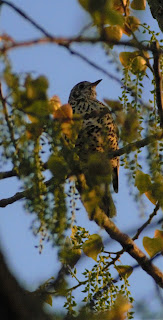Bit more cycling around this week and plenty of bits and bob's to enjoy. The best of the bunch being a migrant Firecrest at the end of the causeway singing its heart out. Often concealed and tricky to follow it did at times venture very close, at times ignoring the social distancing limits and coming within the 2 metre zone we have become very aware of. A lovely couple of hours spent in a tiny dell by the roadside with this tiny firecracker, of course lots of pics.
Will Burdett had been enjoying some Grasshopper Warblers reeling on the edge of town so I rode by there the other day and enjoyed them too.
A Willow Warbler singing it's heart out is all too notable these days and it did well not to be drowned out by the cacophanous Cetti's Warblers which seem to be singing from every tangle and bramble patch, even alongside the railway station platform.
Back on the Yorkshire patch of our youths Jono Leadley landed a truly fantastic find in the form of a superb Red-rumped Swallow.
http://birdingdad.blogspot.com/2020/04/lockdown-birding-red-rumped-swallow.html?m=1
Moving into May we can cross our fingers and hope the month of sunshine and high pressure continues to encourage migrants from southern climes to extend their journey northwards. A Montagu's Harrier lingering across the fields would be pretty fine but going wild a Beeater would truly blow our minds. Moving years worth of pictures off the laptop onto hard drives I stumbled upon these 2 pics of Ben's from our ash-cloud ridden Spanish odyssey and impromptu trans-europe road trip.
http://birdingdad.blogspot.com/2020/04/lockdown-birding-red-rumped-swallow.html?m=1
Moving into May we can cross our fingers and hope the month of sunshine and high pressure continues to encourage migrants from southern climes to extend their journey northwards. A Montagu's Harrier lingering across the fields would be pretty fine but going wild a Beeater would truly blow our minds. Moving years worth of pictures off the laptop onto hard drives I stumbled upon these 2 pics of Ben's from our ash-cloud ridden Spanish odyssey and impromptu trans-europe road trip.


































